Designing an Ecological Network in Yichang Central City in China Based on Habitat Quality Assessment
Abstract
:1. Introduction
2. Study Area and Data Sources
2.1. Overview of the Study Area
2.2. Data Sources
3. Research Methodology
3.1. Focal Species Selection
3.2. Habitat Quality Assessment Based on the InVEST Model
3.3. Ecological Source Site Identification Based on MSPA and Landscape Connectivity Index
3.4. Resistance Surface Construction Based on Hierarchical Analysis
3.5. Simulation of Ecological Corridors Based on Least-Cost Paths
3.6. Ecological Node Identification Based on Circuit Theory
3.7. Analysis of Ecological Network Structure Based on Complex Networks
4. Results and Analysis
4.1. Habitat Quality Assessment
4.2. Ecological Source Site Identification
4.3. Resistance Surface Construction and Ecological Corridor Simulation
4.4. Ecological Node Identification
4.5. Ecological Network Structure
5. Discussion
6. Conclusions
- (1)
- The high-quality habitats in the central city of Yichang are mainly distributed outside the built-up area, with an overall scattered and locally aggregated distribution, and the habitat quality distribution of the three focal species varies greatly.
- (2)
- Based on the results of habitat quality evaluation, the ecological network of the central city of Yichang was designed, and 31 ecological source sites were extracted, with a total area of 108,192.51 ha, accounting for 28.26% of the study area. By spatial characteristics, the ecological source sites were distributed more in the southeast and northwest and less in the middle. A total of 64 ecological corridors were simulated, with a length of 1154.63 km, and corridor density was high in the north and low in the south. A total of 151 nodes were identified, of which 93 were ecological pinch points and 58 were ecological barrier points.
- (3)
- With a relative lack of biological information in urbanized areas, it is feasible to design ecological networks based on the focal species approach and the results of habitat quality evaluation. The results of the study have significance and practical value for the construction of ecological networks targeting biodiversity conservation in rapidly urbanizing areas, and can also provide references and lessons for the construction of ecological networks in other areas.
Supplementary Materials
Author Contributions
Funding
Institutional Review Board Statement
Informed Consent Statement
Data Availability Statement
Conflicts of Interest
References
- Ma, Y.; Li, F.; Yang, R. Impacts of urbanization on biodiversity and control measures. Chin. Landsc. Archit. 2021, 37, 6–13. [Google Scholar]
- Zhong, L.; Yang, R.; Xue, F. A review of urban biodiversity conservation studies. Chin. Landsc. Archit. 2021, 37, 25–30. [Google Scholar]
- Collinge, S.K. Ecological consequences of habitat fragmentation: Implications for landscape architecture and planning. Landsc. Urban Plan. 1996, 36, 59–77. [Google Scholar] [CrossRef]
- Adriaensen, F.; Chardon, J.P.; De Blust, G.; Swinnen, E.; Villalba, S.; Gulinck, H.; Matthysen, E. The application of ‘least-cost’ modelling as a functional landscape model. Landsc. Urban Plan. 2003, 64, 233–247. [Google Scholar] [CrossRef]
- Yu, K.; Li, D.; Duan, T. A landscape planning approach to biodiversity conservation. Biodivers. Sci. 1998, 3, 45–52. [Google Scholar]
- Jones-Walters, L. Pan-European ecological networks. J. Nat. Conserv. 2007, 15, 262–264. [Google Scholar] [CrossRef]
- Kowarik, I. Novel urban ecosystems, biodiversity, and conservation. Environ. Pollut. 2011, 159, 1974–1983. [Google Scholar] [CrossRef] [PubMed]
- Jongman, R.H.G.; Külvik, M.; Kristiansen, I. European ecological networks and greenways. Landsc. Urban Plan. 2004, 68, 305–319. [Google Scholar] [CrossRef]
- Biondi, E.; Casavecchia, S.; Pesaresi, S.; Zivkovic, L. Natura 2000 and the Pan-European ecological network: A new methodology for data integration. Biodivers. Conserv. 2012, 21, 1741–1754. [Google Scholar] [CrossRef]
- Shen, J.K.; Wang, Y.C. Landscape ecological network planning: Shifting from spatial structure priority to ecosystem service enhancement for ecological spatial system construction. Landsc. Archit. 2020, 27, 37–42. [Google Scholar]
- Kong, F.; Yin, H.; Nakagoshi, N.; Zong, Y. Urban green space network development for biodiversity conservation: Identification based on graph theory and gravity modeling. Landsc. Urban Plan. 2010, 95, 16–27. [Google Scholar] [CrossRef]
- Miao, Z.; Pan, L.; Wang, Q.; Chen, P.; Yan, C.; Liu, L. Research on urban ecological network under the threat of road networks—A case study of Wuhan. ISPRS Int. J. Geo-Inf. 2019, 8, 342. [Google Scholar] [CrossRef]
- Xu, Q.; Tian, Y.; Hu, Y.; Liu, B.; Guo, Y. Construction and optimization of wetland ecological network in Daqing City. J. Gansu Agric. Univ. 2020, 55, 153–160. [Google Scholar]
- Mo, Z.C.; Fu, L.H.; Peng, Y.H.; Xie, M. Identification of key nodes of ecological spatial network based on comprehensive importance evaluation. J. Hunan Univ. Technol. 2018, 32, 64–69. [Google Scholar]
- Ersoy, E.; Jorgensen, A.; Warren, P.H. Identifying multispecies connectivity corridors and the spatial pattern of the landscape. Urban For. Urban Green. 2019, 40, 308–322. [Google Scholar] [CrossRef]
- Liu, X.Y.; Wei, M.; Zeng, J.; Zhang, S. Analysis and construction of ecological network in Min Delta City Cluster. Resour. Sci. 2021, 43, 357–367. [Google Scholar]
- An, C.; Shen, Q.J. Green infrastructure network construction method based on ecological performance of spatial utilization. Landsc. Archit. 2013, 2, 22–31. [Google Scholar]
- Peng, J.; Yang, Y.; Liu, Y.; Hu, Y.; Du, Y.; Meersmans, J.; Qiu, S. Linking ecosystem services and circuit theory to identify ecological security patterns. Sci. Total Environ. 2018, 644, 781–790. [Google Scholar] [CrossRef]
- Zhang, L.; Peng, J.; Liu, Y.; Wu, J. Coupling ecosystem services supply and human ecological demand to identify landscape ecological security pattern: A case study in Beijing–Tianjin–Hebei region, China. Urban Ecosyst. 2017, 20, 701–714. [Google Scholar] [CrossRef]
- Lu, M.; Qu, Y. Construction of regional ecological network based on ecosystem service functions—Harbin as an example. Chin. Landsc. Archit. 2017, 33, 103–107. [Google Scholar]
- Mengist, W.; Soromessa, T.; Feyisa, G.L. Landscape change effects on habitat quality in a forest biosphere reserve: Implications for the conservation of native habitats. J. Clean. Prod. 2021, 329, 129778. [Google Scholar] [CrossRef]
- Di, F.M.; Sallustio, L.; Vizzarri, M.; De Rosa, D.; De Lisio, L.; Loy, A.; Eichelberger, B.A.; Marchetti, M. Expert-based and correlative models to map habitat quality: Which gives better support to conservation planning? Glob. Ecol. Conserv. 2018, 16, e513. [Google Scholar]
- Moreira, M.; Fonseca, C.; Vergílio, M.; Calado, H. Spatial assessment of habitat conservation status in a Macaronesian island based on the InVEST model: A case study of Pico Island (Azores, Portugal). Land Use Policy 2018, 78, 637–649. [Google Scholar] [CrossRef]
- Sharp, R.; Tallis, H.T.; Ricketts, T.; Guerry, A.D.; Wood, S.A.; Chaplin-Kramer, R.; Nelson, E.J.; Ennaanay, D.; Wolny, S.; Olwero, N.; et al. InVEST 3.7.0 User’s Guide; The Natural Capital Project; Stanford University: Stanford, CA, USA; University of Minnesota: Minneapolis, MI, USA; The Nature Conservancy: Arlington, VA, USA; World Wildlife Fund: New York, NY, USA, 2019. [Google Scholar]
- Zhang, M.D.; Zhang, F.; Li, X. Habitat quality evaluation based on the InVEST model: An example from Tongzhou District, Beijing. Landsc. Archit. 2020, 27, 95–99. [Google Scholar]
- Gong, L. Research on the Optimization of Ecological Network in Central Beijing Based on Habitat Quality Evaluation. Master’s Thesis, Beijing Forestry University, Beijing, China, 2021. [Google Scholar]
- Terrado, M.; Sabater, S.; Chaplin-Kramer, B.; Mandle, L.; Ziv, G.; Acuña, V. Model development for the assessment of terrestrial and aquatic habitat quality in conservation planning. Sci. Total Environ. 2016, 540, 63–70. [Google Scholar] [CrossRef] [PubMed]
- Lambeck, R.J. Focal species: A multi-species umbrella for nature conservation. Conserv. Biol. 1997, 11, 849–856. [Google Scholar] [CrossRef]
- Brooker, L. The application of focal species knowledge to landscape design in agricultural lands using the ecological neighbourhood as a template. Landsc. Urban Plan 2002, 60, 185–210. [Google Scholar] [CrossRef]
- Billeter, R.; Liira, J.; Bailey, D.; Bugter, R.; Arens, P.; Augenstein, I.; Aviron, S.; Baudry, J.; Bukacek, R.; Burel, F.; et al. Indicators for biodiversity in agricultural landscapes: A pan-European study. J. Appl. Ecol. 2008, 45, 141–150. [Google Scholar] [CrossRef]
- Hess, G.R.; King, T.J. Planning open spaces for wildlife: I. Selecting focal species using a Delphi survey approach. Landsc. Urban Plan. 2002, 58, 25–40. [Google Scholar] [CrossRef]
- Rubino, M.J.; Hess, G.R. Planning open spaces for wildlife 2: Modeling and verifying focal species habitat. Landsc. Urban Plan. 2003, 64, 89–104. [Google Scholar] [CrossRef]
- Simberloff, D. Flagships, umbrellas, and keystones: Is single-species management passé in the landscape era? Biol. Conserv. 1998, 83, 247–257. [Google Scholar] [CrossRef]
- Wilcox, B.A. In Situ Conservation of Genetic Resources: Determinants of Minimum area Requirements. In Proceedings of the World Congress on National Parks, Bali, Indonesia, 11–22 October 1982; Smithsonian Institution Press: Washington, DC, USA, 1984. [Google Scholar]
- Power, M.E.; Tilman, D.; Estes, J.A.; Menge, B.A.; Bond, W.J.; Mills, L.S.; Daily, G.; Castilla, J.C.; Lubchenco, J.; Paine, R.T. Challenges in the quest for keystones. Bioscience 1996, 46, 609–620. [Google Scholar] [CrossRef]
- Liu, X.X. The Complete Fauna of the Three Gorges of the Yangtze River in China; Science Press: Beijing, China, 2010. [Google Scholar]
- Wang, L.R.; Feng, X.L.; Chang, Q.; Liu, H.; Wang, J. Study on the construction of urban green space habitat network pattern based on InVEST-MCR composite model. Chin. Landsc. Archit. 2020, 36, 113–118. [Google Scholar]
- Zhang, L.; He, L.; Yan, F.; Chen, Y. Habitat network planning for amphibians based on graph theory: The example of the black-spotted side-pleated frog. Chin. J. Appl. Ecol. 2021, 32, 1054–1060. [Google Scholar]
- Zhao, J.; Liang, Y.Q.; Mei, J. Target Species-Oriented Urban Habitat Network Construction. In Proceedings of the Annual Meeting of the Chinese Society of Landscape Architecture, Chengdu, China, 21–23 November 2020. [Google Scholar]
- Zhao, Z.J. Chinese Birds; Jilin Science and Technology Press: Changchun, China, 2001. [Google Scholar]
- Fei, L.; Hu, S.Q.; Ye, C.Y.; Huang, Y.Z. Zoology of China: Amphibians; Science Press: Beijing, China, 2009. [Google Scholar]
- Luo, Z.X. Chinese Wild Rabbit; China Forestry Press: Beijing, China, 1988. [Google Scholar]
- Chen, Y.; Qiao, F.; Jiang, L. Impact of land use pattern change on regional scale habitat quality based on InVEST model in Beijing. J. Peking Univ. Nat. Sci. Ed. 2016, 52, 553–562. [Google Scholar]
- Pan, D.Y. Toxicity of herbicides to the tadpoles of the zebra frog (Pleurotus ocellatus). Chin. J. Zool. 1990, 1, 32–33. [Google Scholar]
- Li, Y.; Xu, F.; Guo, Z.; Liu, X.; Jin, C.; Wang, Y.; Wang, S. Reduced predator species richness drives the body gigantism of a frog species on the Zhoushan Archipelago in China. J. Anim. Ecol. 2015, 80, 171–182. [Google Scholar] [CrossRef]
- Ke, X.; Guo, W.; Huang, J.; Deng, H.; Liu, Z.; Wang, X.; Xie, G.; Liu, T. Amphibian diversity in suburban rice fields of Ji’an City. J. Jinggangshan Univ. Nat. Sci. Ed. 2013, 34, 103–106. [Google Scholar]
- Han, X. Impact Assessment of Terrestrial Ecological Environment of Large Water Conservancy Projects. Master’ Thesis, Huaqiao University, Quanzhou, China, 2021. [Google Scholar]
- Tang, Y.; Gao, C.; Wu, X. Urban ecological corridor network construction: An integration of the least cost path model and the InVEST model. ISPRS Int. J. Geo-Inf. 2020, 9, 33. [Google Scholar] [CrossRef]
- Berta, A.A.; Noszczyk, T.; Soromessa, T.; Elies, E. The InVEST habitat quality model associated with land use/cover changes: A qualitative case study of the Winike Watershed in the Omo-Gibe Basin, Southwest Ethiopia. Remote Sens. 2020, 12, 1103. [Google Scholar] [CrossRef]
- Sulistyawan, B.S.; Eichelberger, B.A.; Verweij, P.; Boot, R.G.A.; Hardian, O.; Adzan, G.; Sukmantoro, W. Connecting the fragmented habitat of endangered mammals in the landscape of Riau–Jambi–Sumatera Barat (RIMBA), central Sumatra, Indonesia (connecting the fragmented habitat due to road development). Glob. Ecol. Conserv. 2017, 9, 116–130. [Google Scholar] [CrossRef]
- Qiu, Y.; Chang, Q.; Wang, J. MSPA-based urban green infrastructure network planning—Shenzhen as an example. Chin. Landsc. Archit. 2013, 29, 104–108. [Google Scholar]
- Soille, P.; Vogt, P. Morphological segmentation of binary patterns. Pattern Recognit. Lett. 2009, 30, 456–459. [Google Scholar] [CrossRef]
- Wickham, J.D.; Riitters, K.H.; Wade, T.G.; Vogt, P. A national assessment of green infrastructure and change for the conterminous United States using morphological image processing. Landsc. Urban Plan. 2010, 94, 186–195. [Google Scholar] [CrossRef]
- Smith, M.A.; Green, D.M. Dispersal and the metapopulation paradigm in amphibian ecology and conservation: Are all amphibian populations metapopulations? Ecography 2005, 28, 110–128. [Google Scholar] [CrossRef]
- Semlitsch, R.D. Differentiating migration and dispersal processes for pond-breeding amphibians. J. Wildl. Manag. 2008, 72, 260–267. [Google Scholar] [CrossRef]
- Sun, S.X. Life habits, activity patterns and hunting of hares. Chin. J. Zool. 1984, 4, 26–29. [Google Scholar]
- Tittler, R.; Villard, M.; Fahrig, L. How far do songbirds disperse? Ecography 2009, 32, 1051–1061. [Google Scholar] [CrossRef]
- Zhang, L.; Tian, B.; Zhou, Y.; Zhu, C. Analysis of urban ecological network pattern in Pudong New Area of Shanghai supported by remote sensing and GIS. J. East China Norm. Univ. Nat. Sci. Ed. 2015, 1, 240–251. [Google Scholar]
- Liu, Y.; Huang, T.; Zheng, X. A method of linking functional and structural connectivity analysis in urban green infrastructure network construction. Urban Ecosyst. 2022, 25, 909–925. [Google Scholar] [CrossRef]
- Teng, M.; Wu, C.; Zhou, Z.; Lord, E.; Zheng, Z. Multipurpose greenway planning for changing cities: A framework integrating priorities and a least-cost path model. Landsc. Urban Plan. 2011, 103, 14. [Google Scholar] [CrossRef]
- Zhu, J.; Su, J.; Yin, H.-W.; Kong, F.-H. Construction of Xuzhou ecological network based on integrated source site identification and multi-scale nesting. J. Nat. Resour. 2020, 35, 1986–2001. [Google Scholar]
- Kim, J.E. Green network analysis in coastal cities using least-cost path analysis: A study of Jakarta, Indonesia. J. Ecol. Environ. 2012, 35, 141–147. [Google Scholar] [CrossRef]
- McRae, B.H.; Beier, P. Circuit theory predicts gene flow in plant and animal populations. Proc. Natl. Acad. Sci. USA 2007, 104, 19885–19890. [Google Scholar] [CrossRef] [PubMed]
- Xu, W.; Wang, J.; Zhang, M.; Li, S. Construction of landscape ecological network based on landscape ecological risk assessment in a large-scale opencast coal mine area. J. Clean. Prod. 2021, 286, 125523. [Google Scholar] [CrossRef]
- Xu, W.X. Study on the Dynamic Evolution of Ecological Risk and Spatial Optimization of Ecological Network in Large Open-Pit Mining Area. Master’s Thesis, China University of Geosciences, Beijing, China, 2021. [Google Scholar]
- Cui, L.; Wang, J.; Sun, L.; Lv, C. Construction and optimization of green space ecological networks in urban fringe areas: A case study with the urban fringe area of Tongzhou district in Beijing. J. Clean. Prod. 2020, 276, 124266. [Google Scholar] [CrossRef]
- Huang, B.; Chiou, S.; Li, W. Landscape Pattern and Ecological Network Structure in Urban Green Space Planning: A Case Study of Fuzhou City. Land 2021, 10, 769. [Google Scholar] [CrossRef]
- Zhou, L.; Li, M.H.; Zhou, Q.G.; Meng, H.B.; Peng, C.H.; Liu, X.W. Constructing ecological security patterns in mega-mountain cities based on circuit theory: The case of Chongqing metropolitan area. Soil Water Conserv. Res. 2021, 28, 319–325. [Google Scholar]
- Carroll, C. Role of climatic niche models in focal-species-based conservation planning: Assessing potential effects of climate change on Northern Spotted Owl in the Pacific Northwest, USA. Biol. Conserv. 2010, 143, 1432–1437. [Google Scholar] [CrossRef]
- Liu, X.Y. Research on the Planning and Design of Urban and Rural Greenways Based on Biodiversity Conservation. Master’s Thesis, Beijing Forestry University, Beijing, China, 2020. [Google Scholar]
- Chen, H.Y.; Li, X. Optimization of green space habitat network in central Beijing based on MSPA-InVEST model. Landsc. Archit. 2021, 28, 16–21. [Google Scholar]
- Chen, N.N.; Kang, S.Z.; Zhao, Y.H.; Zhou, Y.J.; Yan, J.; Lu, Y.R. Construction of a mountain ecological network based on MSPA and MCR models in the Qinling Mountains (Shaanxi section). Chin. J. Appl. Ecol. 2021, 32, 1545–1553. [Google Scholar]
- Hepcan, E.; Hepcan, C.C.; Bouwma, I.M.; Jongman, R.H.G.; Özkan, M.B. Ecological networks as a new approach for nature conservation in Turkey: A case study of İzmir Province. Landsc. Urban Plan. 2009, 90, 143–154. [Google Scholar] [CrossRef]
- Ecological Landscape Planning for the Central City of Yichang. 2015. Available online: http://zrzy.yichang.gov.cn/content-61247-9359-1.html (accessed on 10 May 2023).
- Wu, J.; Delang, C.O.; Li, Y.; Ye, Q.; Zhou, J.; Liu, H.; He, H.; He, W. Application of a combined model simulation to determine ecological corridors for western black-crested gibbons in the Hengduan Mountains, China. Ecol. Indic. 2021, 128, 107826. [Google Scholar] [CrossRef]
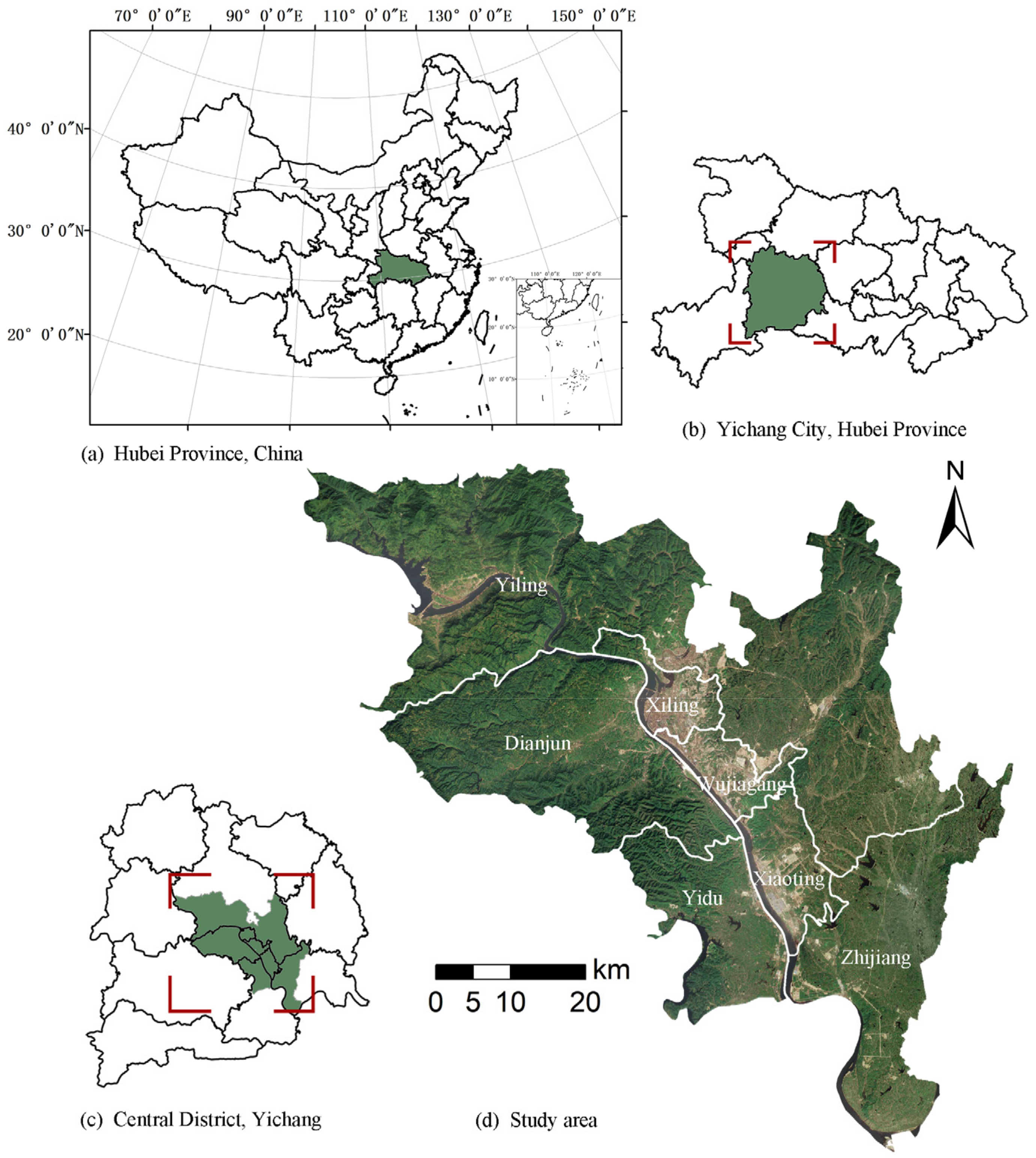
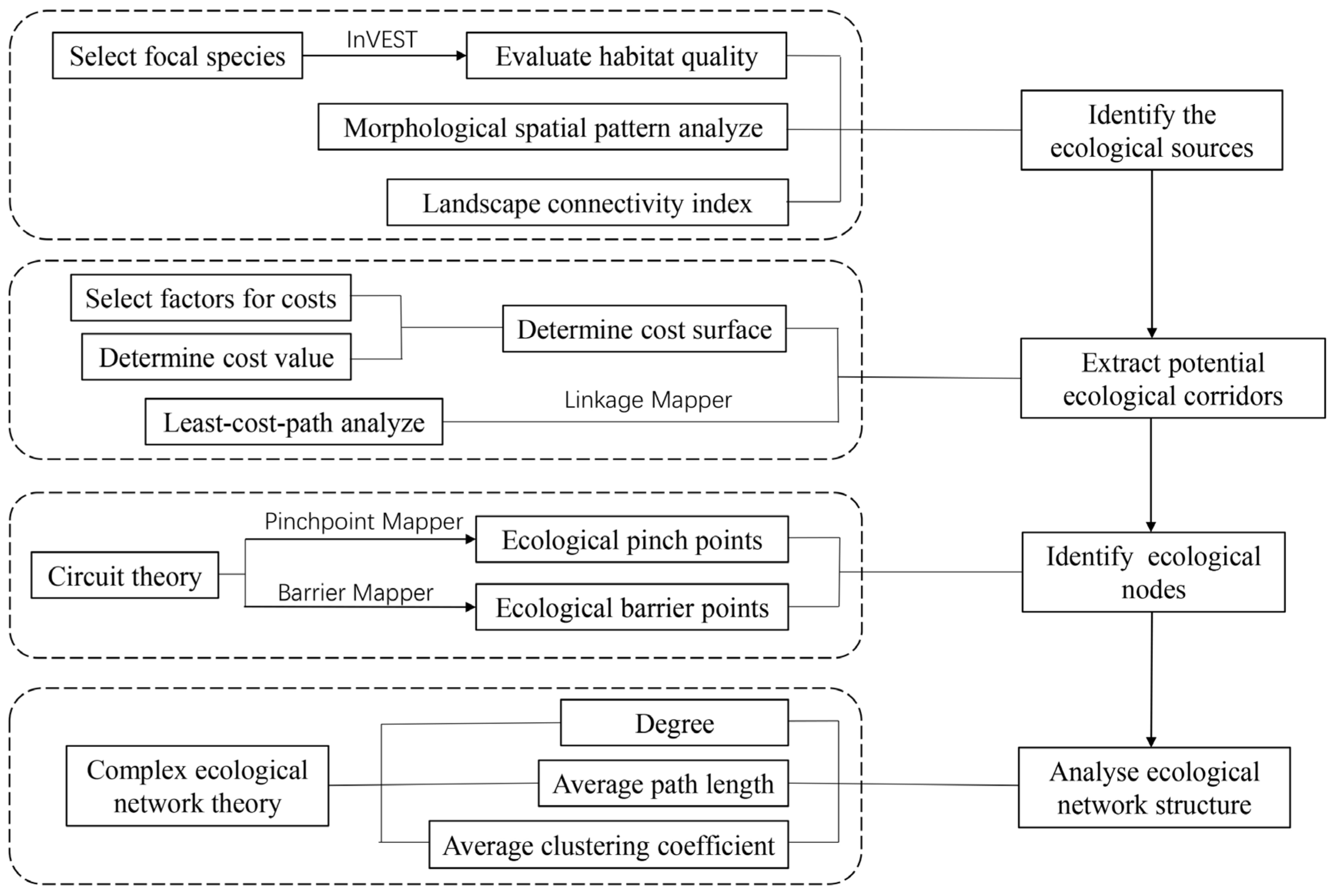
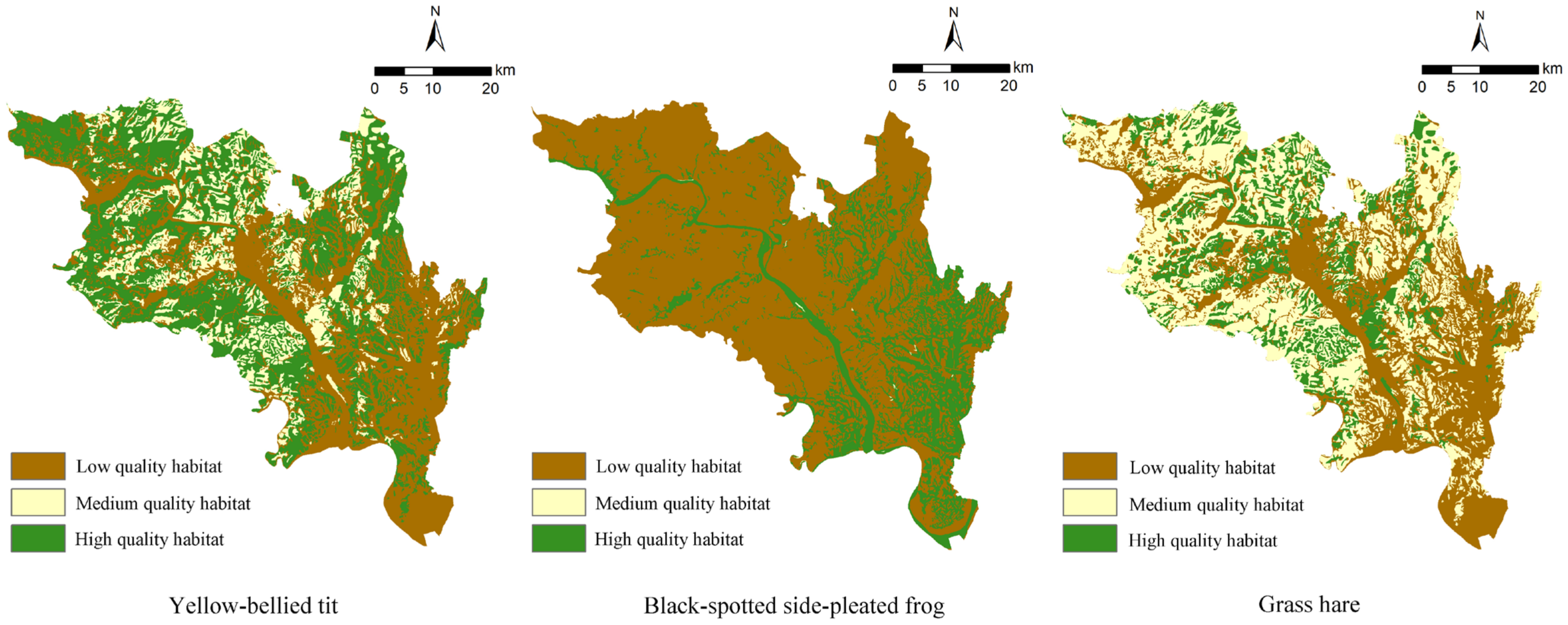

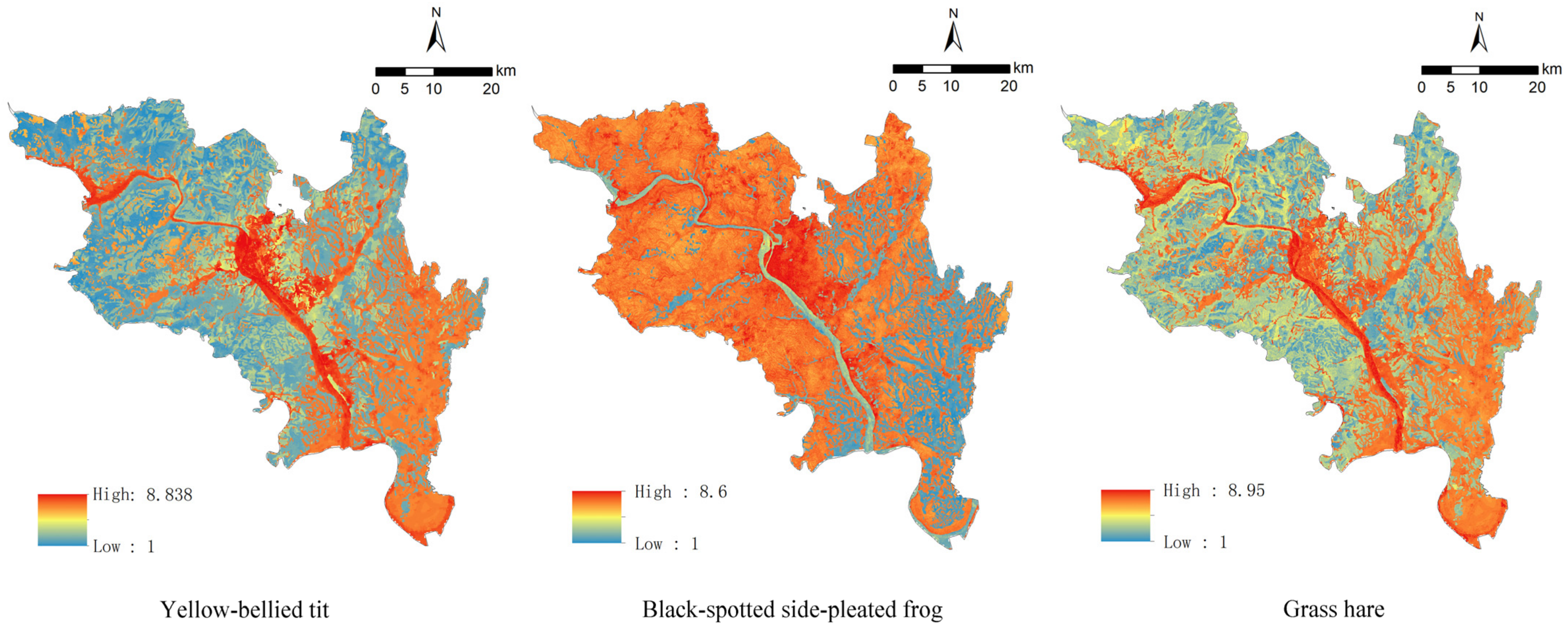


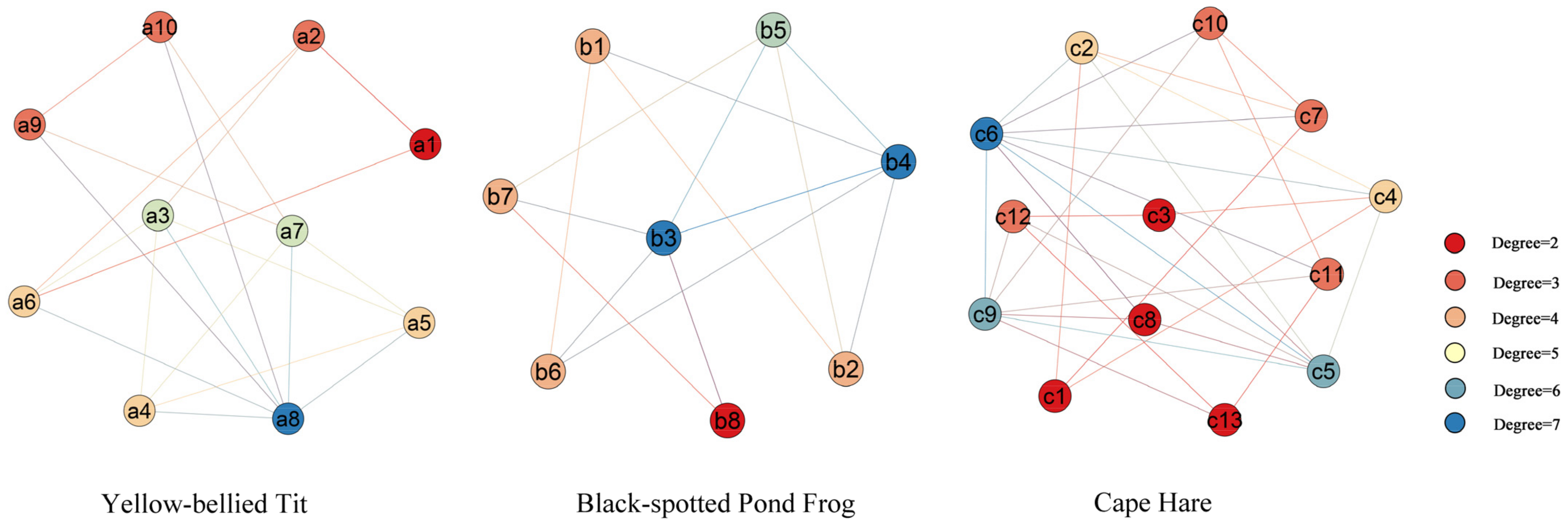

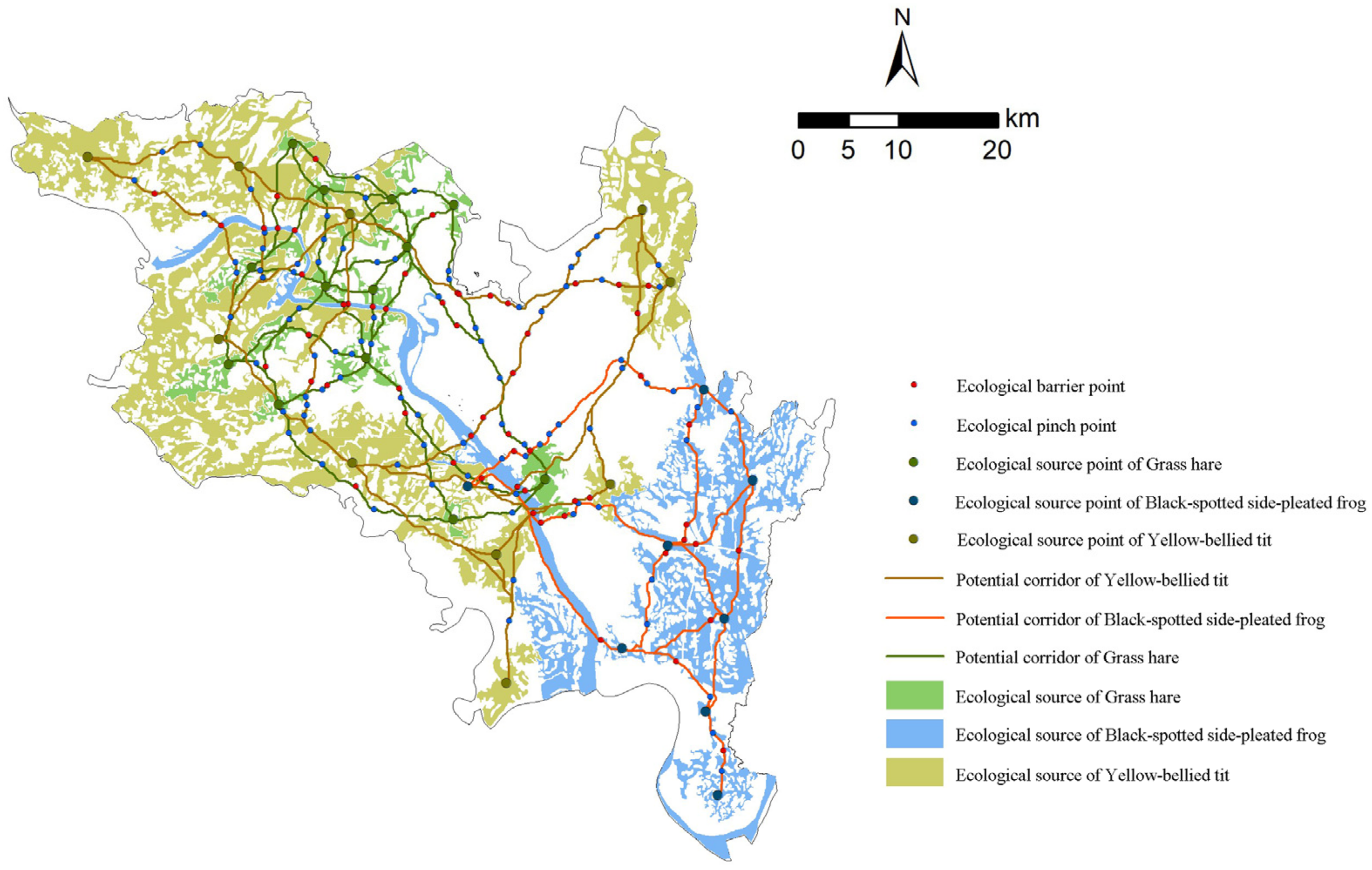
| Data | Source | Spatial Resolution |
|---|---|---|
| Land use data for 2020 | Resource and Environmental Science Data Service Center of the Chinese Academy of Sciences (http://www.resdc.cn (accessed on 5 February 2022)), and further corrected the data based on Google Earth HD historical images with visual interpretation | 30 m |
| Digital Elevation Model (DEM) | Geospatial Data Cloud Platform of Chinese Academy of Sciences (http://wwwgscloud.cn/ (accessed on 4 January 2022)) | 30 m |
| eMODIS normalized vegetation index (NDVI) data | U.S. Geological Survey website (http://www.usgs.gov/ (accessed on 4 January 2022)) | 250 m |
| NPP/VIIRS night lighting data | National Oceanic and Atmospheric Administration website (http://www.noaa.gov/ (accessed on 6 February 2022)) | 500 m |
| Road data | OpenStreetMap | - |
| Species | Yellow-Bellied Tit (Parus venustulus) | Black-Spotted Side-Pleated Frog (Pelophylax nigromaculatus) | Grass Hare (Lepus capensis) |
|---|---|---|---|
| Animal category | Birds, climbing birds | Amphibians | Small mammals |
| Habitat characteristics | It mainly inhabits various forests in the mountains below 2000 m in altitude and descends to secondary forests, plantation forests and forest edge sparse scrub areas in the low mountains and foot plains in winter [40] | It lives in coastal plains to hills and mountains at an altitude of about 2000 m. It is commonly found in paddy fields, ponds, lakes and ditches near still water or slow flowing rivers [41] | Most of the subspecies in the Yangtze River valley are distributed in the mountains of the red loam belt and live mostly in winter around villages, narrow valleys, ravines, scrubs and grasses at the edge of fields. In summer and autumn, they tend to dig holes in the forest or scrub on ventilated and cool hills [42] |
| Protection level | China’s special birds; List of Terrestrial Wild Animals of National Protection Beneficial or of Economic or Scientific Research Value (China); Red List of Threatened Species (IUCN): 2016–Least Concern (LC) | Red List of Threatened Species (IUCN) ver 3.1: 2004–Near Threatened (NT); Red List of China’s Biodiversity—Vertebrates Volume (Amphibians)—Near Threatened (NT) | List of Terrestrial Wild Animals of National Protection Beneficial or of Economic or Scientific Research Value (China); Red List of Mammalia rabbits (IUCN) ver 3.1: 2008–Low Risk (LC) |
| Habitat Quality | Yellow-Bellied Tit | Black-Spotted Side-Pleated Frog | Grass Hare | |||
|---|---|---|---|---|---|---|
| Area (ha) | Proportion | Area (ha) | Proportion | Area (ha) | Proportion | |
| Low(0~0.5) | 109,834.2 | 38.78% | 214,167.15 | 75.62% | 111,075.21 | 39.22% |
| Medium (0.5~0.8) | 50,321.07 | 17.77% | 216.54 | 0.08% | 120,743.19 | 42.63% |
| High (0.8~1) | 123,055.65 | 43.45% | 68,827.23 | 24.30% | 51,392.52 | 18.15% |
| Total | 283,210.92 | 100.00% | 283,210.92 | 100.00% | 283,210.92 | 100.00% |
| Yellow-Bellied Tit | dPC | Area/ha | Black-Spotted Side-Pleated Frog | dPC | Area/ha | Grass Hare | dPC | Area/ha |
|---|---|---|---|---|---|---|---|---|
| a1 | 15.41 | 6467.58 | b1 | 8.46 | 1695.60 | c1 | 6.33 | 272.79 |
| a2 | 25.91 | 9875.70 | b2 | 28.37 | 5611.50 | c2 | 11.67 | 591.21 |
| a3 | 9.41 | 3803.13 | b3 | 39.06 | 368.82 | c3 | 7.41 | 594.18 |
| a4 | 11.48 | 5748.66 | b4 | 58.79 | 5661.90 | c4 | 21.98 | 1185.48 |
| a5 | 5.93 | 2743.65 | b5 | 43.44 | 6300.81 | c5 | 7.77 | 397.62 |
| a6 | 42.40 | 15,645.33 | b6 | 49.31 | 10,145.79 | c6 | 28.42 | 735.39 |
| a7 | 3.74 | 1310.49 | b7 | 6.20 | 186.30 | c7 | 14.09 | 1064.61 |
| a8 | 37.41 | 12,533.49 | b8 | 14.23 | 3513.24 | c8 | 16.81 | 535.95 |
| a9 | 11.79 | 3347.64 | c9 | 28.01 | 1586.70 | |||
| a10 | 4.01 | 1771.74 | c10 | 19.09 | 1965.60 | |||
| c11 | 8.14 | 519.03 | ||||||
| c12 | 12.52 | 1702.08 | ||||||
| c13 | 7.06 | 310.50 |
| Species | Serial Number | Ecological Corridor | Length (km) | Cumulative Resistance Value |
|---|---|---|---|---|
| Yellow-bellied tit | 1 | Corridor 1–2 | 17.473 | 1480 |
| 2 | Corridor 1–6 | 29.381 | 3826 | |
| 3 | Corridor 2–3 | 13.281 | 1561 | |
| 4 | Corridor 2–6 | 20.56 | 3204 | |
| 5 | Corridor 3–4 | 40.495 | 8029 | |
| 6 | Corridor 3–5 | 39.286 | 8537 | |
| 7 | Corridor 3–6 | 20.131 | 1688 | |
| 8 | Corridor 3–8 | 30.674 | 4791 | |
| 9 | Corridor 4–5 | 8.539 | 1366 | |
| 10 | Corridor 4–7 | 30.97 | 4349 | |
| 11 | Corridor 4–8 | 45.642 | 10,958 | |
| 12 | Corridor 5–7 | 24.62 | 3684 | |
| 13 | Corridor 5–8 | 47.545 | 5914 | |
| 14 | Corridor 6–8 | 19.953 | 2479 | |
| 15 | Corridor 7–8 | 29.422 | 6243 | |
| 16 | Corridor 7–9 | 14.779 | 4577 | |
| 17 | Corridor 7–10 | 27.434 | 6784 | |
| 18 | Corridor 8–9 | 19.326 | 2445 | |
| 19 | Corridor 8–10 | 32.202 | 3058 | |
| 20 | Corridor 9–10 | 13.983 | 1838 | |
| Black-spotted side-pleated frog | 1 | Corridor 1–2 | 11.519 | 6380 |
| 2 | Corridor 1–4 | 18.849 | 8876 | |
| 3 | Corridor 1–6 | 32.836 | 31,698 | |
| 4 | Corridor 2–4 | 12.531 | 6216 | |
| 5 | Corridor 2–5 | 15.137 | 3406 | |
| 6 | Corridor 3–4 | 14.147 | 11,827 | |
| 7 | Corridor 3–5 | 12.466 | 5209 | |
| 8 | Corridor 3–6 | 26.991 | 15,373 | |
| 9 | Corridor 3–7 | 12.853 | 5543 | |
| 10 | Corridor 3–8 | 22.145 | 10,329 | |
| 11 | Corridor 4–5 | 10.752 | 3239 | |
| 12 | Corridor 4–6 | 26.703 | 16,720 | |
| 13 | Corridor 5–7 | 10.381 | 5094 | |
| 14 | Corridor 7–8 | 9.551 | 5354 | |
| Grass hare | 1 | Corridor 1–2 | 6.376 | 1366 |
| 2 | Corridor 1–4 | 12.623 | 3208 | |
| 3 | Corridor 1–7 | 14.753 | 3120 | |
| 4 | Corridor 2–4 | 7.378 | 1570 | |
| 5 | Corridor 2–5 | 11.817 | 2284 | |
| 6 | Corridor 2–6 | 10.738 | 2769 | |
| 7 | Corridor 2–7 | 11.851 | 2334 | |
| 8 | Corridor 3–4 | 7.288 | 1887 | |
| 9 | Corridor 3–5 | 7.367 | 1185 | |
| 10 | Corridor 3–12 | 32.9 | 10,667 | |
| 11 | Corridor 4–5 | 5.781 | 1079 | |
| 12 | Corridor 4–6 | 12.307 | 2862 | |
| 13 | Corridor 5–6 | 10.383 | 2365 | |
| 14 | Corridor 5–8 | 5.917 | 1358 | |
| 15 | Corridor 5–9 | 13.287 | 3542 | |
| 16 | Corridor 5–12 | 30.516 | 9928 | |
| 17 | Corridor 6–7 | 8.578 | 2167 | |
| 18 | Corridor 6–8 | 5.12 | 1120 | |
| 19 | Corridor 6–9 | 9.875 | 2619 | |
| 20 | Corridor 6–10 | 13.828 | 1903 | |
| 21 | Corridor 6–11 | 15.993 | 3425 | |
| 22 | Corridor 7–10 | 11.102 | 2125 | |
| 23 | Corridor 8–9 | 7.255 | 3049 | |
| 24 | Corridor 9–10 | 17.032 | 3435 | |
| 25 | Corridor 9–11 | 11.159 | 2575 | |
| 26 | Corridor 9–12 | 26.034 | 6709 | |
| 27 | Corridor 9–13 | 20.43 | 4610 | |
| 28 | Corridor 10–11 | 8.383 | 1592 | |
| 29 | Corridor 11–13 | 24.711 | 4926 | |
| 30 | Corridor 12–13 | 11.286 | 3099 |
Disclaimer/Publisher’s Note: The statements, opinions and data contained in all publications are solely those of the individual author(s) and contributor(s) and not of MDPI and/or the editor(s). MDPI and/or the editor(s) disclaim responsibility for any injury to people or property resulting from any ideas, methods, instructions or products referred to in the content. |
© 2023 by the authors. Licensee MDPI, Basel, Switzerland. This article is an open access article distributed under the terms and conditions of the Creative Commons Attribution (CC BY) license (https://creativecommons.org/licenses/by/4.0/).
Share and Cite
You, G.; Chen, T.; Shen, P.; Hu, Y. Designing an Ecological Network in Yichang Central City in China Based on Habitat Quality Assessment. Sustainability 2023, 15, 8313. https://doi.org/10.3390/su15108313
You G, Chen T, Shen P, Hu Y. Designing an Ecological Network in Yichang Central City in China Based on Habitat Quality Assessment. Sustainability. 2023; 15(10):8313. https://doi.org/10.3390/su15108313
Chicago/Turabian StyleYou, Guixuan, Tianyi Chen, Peixin Shen, and Yuandong Hu. 2023. "Designing an Ecological Network in Yichang Central City in China Based on Habitat Quality Assessment" Sustainability 15, no. 10: 8313. https://doi.org/10.3390/su15108313





